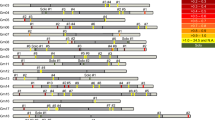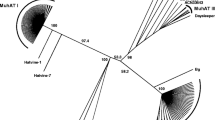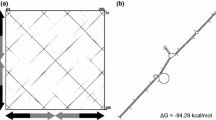Abstract
We have investigated the organization of the transposon Tam3 family in Antirrhinum majus. Genomic hybridization experiments and characterization of 40 independent Tam3 clones isolated from an A. majus plant revealed that the Tam3 family is quite conserved and the copy sizes are uniform. We did not find any copy with a deleted internal sequence, unlike what is usually observed in other transposons. This exceptionally conserved structure of the Tam3 family was confirmed by PCR and sequencing analyses. Sequencing analysis identified eight copies with sequences completely identical to that of the Tam3 transposase gene. These results suggested that a considerable number of autonomous Tam3 copies are present in the genome of A. majus. Among 24 copies which are surrounded by single copy regions of the genome, 14 copies are present as specific insertions in the line which we used, but absent in other lines. These copies are therefore predicted to be movable. If this ratio is the same for all Tam3 copies in a genome, then a maximum of 60% of the copies are estimated to be movable in the genome. The relatively high frequency of gene tagged by Tam3 might reflect the large number of movable copies in the genome.
Similar content being viewed by others
References
Bennetzen JL: The mutator transposable element system of maize. In: Saedler H, Gierl A (eds) Transposable Elements. Current Topics in Microbiology and Immunology, vol 204, pp. 195–229. Springer-Verlag, Berlin/Heidelberg (1996).
Bradley D, Carpenter R, Sommer H, Hartley N, Coen E: Complementary floral homeotic phenotypes result from opposite orientations of a transposon at the plena locus of Antirrhinum. Cell 72: 85–95 (1993).
Calvi BR, Hong TJ, Findley SD, Gelbart WM: Evidence for a common evolutionary origin of inverted repeat transposons in Drosophila and plants: hobo, Activator, and Tam3. Cell 66: 465–471 (1991).
Chatterjee M, Sparvoli S, Edmunds C, Garosi P, Findlay K, Martin C: DAG, a gene required for chloroplast differentiation and palisade development in Antirrhinum majus. EMBO J 15: 4194–4207 (1996).
Coen ES, Robbins TP, Almeida J, Hudson A, Carpenter R: Consequences and mechanisms of transposition in Antirrhinum majus. In: Berg DE, Howe MH (eds) Mobile DNA, pp. 413–436. American Society for Microbiology, Washington, DC (1989).
Coen ES, Romero JM, Doyle S, Elliott R, Murphy G, Carpenter R: floricaula: a homeotic gene required for flower development in Antirrhinum majus. Cell 63: 1311–1322 (1990).
Döring HP, Starlinger P: Molecular genetics of transposable elements in plants. Annu Rev Genet 20: 175–200 (1986).
Fedoroff NV: Maize transposable elements. In: Berg DE, Howe MH(eds)Mobile DNA, pp. 375–411. American Society for Microbiology, Washington, DC (1989).
Gierl A, Saedler H, Peterson PA: Maize transposable elements. Annu Rev Genet 23: 71–85 (1989).
Haring M, Gao HJ, Volbeda T, Rommens CMT, Nijkamp HJJ, Hille J: A comparative study of Tam3 and Ac transposition in transgenic tobacco and petunia plants. Plant Mol Biol 13: 189–201 (1989).
Haring MA, Vroomen MJT, Nijkamp HJJ, Hille J: Transactivation of an artificial dTam3 transposable element in transgenic tobacco plants. Plant Mol Biol 16: 39–47 (1991).
Hartel DL, Lozovskaya ER, Lawrence JG: Nonautonomous transposable elements in prokaryotes and eukaryotes. Genetica 86: 47–48 (1992).
Hehl R, Nacken W, Krause A, Saedler H, Sommer H: Structural analysis of Tam3, a transposable element from Antirrhinum majus, reveals homologies to the Ac element from maize. Plant Mol Biol 16: 369–371 (1991).
Heinlein M: Excision patterns of Activator (Ac) and Dissociation (Ds) elements in Zea mays L.: implications for the regulation of transposition. Genetics 144: 1851–1869 (1996).
Hsia A, Schnable PS: DNA sequence analyses support the role of interrupted gap repair in the origin of internal deletions of the maize transposon, MuDR. Genetics 142: 603–618 (1996).
Hudson A, Carpenter R, Doyle S, Coen ES: Olive: a key gene required for chlorophyll biosynthesis in Antirrhinum majus. EMBO J 12: 3711–3719 (1993).
Inagaki Y, Hisatomi Y, Suzuki T, Kasahara K, Iida S: Isolation of a suppressor-mutator/enhancer like transposable element, Tpnl, from Japanese Morning Glory bearing variegated flowers. Plant Cell 6: 375–383 (1994).
Kidwell MG, Lisch D: Transposable elements as sources of variation in animals and plants. Proc Natl Acad Sci USA 94: 7704–7711 (1997).
Kishima Y, Yamashita S, Mikami T: Immobilized copies with nearly intact structure of the transposon Tam3 in Antirrhinum majus: implications for cis-element related to the transposition. Theor Appl Genet (in press).
Lisch D, Chomet P, Freeling M: Genetic characterization of the mutator system in maize: behavior and regulation of Mu transposons in a minimal line. Genetics 139: 1777–1796 (1995).
Martin CR, Carpenter ES, Coen ES, Gerats T: The control of floral pigmentation in Antirrhinum majus. In: Thomas H, Grierson D (eds) Developmental Mutants in Higher Plants, pp. 19–52. Cambridge University Press, Cambridge, UK (1987).
Martin C, Carpenter R, Sommer H, Saedler H, Coen ES: Molecular analysis of instability in flower pigmentation of Antirrhinum majus, following isolation of the pallida locus by transposon tagging. EMBO J 4: 1625–1630 (1985).
Martin C, Prescott A, Lister C, Mackay S: Activity of the transposon Tam3 in Antirrhinum and tobacco: possible role of DNA methylation. EMBO J 8: 997–1004 (1989).
McClintock B: Mutable loci in maize. Carnegie Inst Wash Year Book 47: 157–169 (1948).
McClintock B: Chromosome organization and genic expression. Cold Spring Harbor Symp Quant Biol 16: 13–47 (1951).
Nassif N, Penney J, Pal S, Engels WR, Gloor GB: Efficient copying of nonhomologous sequences from ectopic sites via P-element-induced gap repair. Mol Cell Biol 14: 1613–1625 (1994).
Nitasaka E, Yamazaki T: The relationship between DNAstructural variation and activities of P elements in P and Q strains of Drosophila melanogaster. Heredity 73: 608–615 (1993).
Ozeki Y, Davies E, Takeda J: Somatic variation during long term subculturing of plant cells caused by insertion of a transposable element in a phenylalanine ammonia-lyase (PAL) gene. Mol Gen Genet 254: 407–416 (1997).
O'Hare K, Driver A, McGrath S, Johnson-Schiltz DN: Distribution and structure of cloned P elements from the Drosophila melanogaster P strain π2. Genet Res Camb 60: 33–41 (1992).
Rhodes PR, Vodkin LO: Organization of the Tgm family of transposable elements in soybean. Genetics 120: 597–604 (1988).
Rubin E, Levy A: Abortive gap repair: underlying mechanism for Ds element formation. Mol Cell Biol 17: 6294–6302 (1997).
Saedler H, Gierl A: Transposable Elements. Current Topics in Microbiology and Immunology, vol 204. Springer-Verlag, Berlin/Heidelberg (1996).
Sambrook J, Fritsch EF, Maniatis T: Molecular Cloning: A Laboratory Manual, 2nd ed. Cold Spring Harbor Laboratory Press, Cold Spring Harbor, NY (1989).
Scofield SR, English JJ, Jones JDG: High level expression of the Activator (Ac) transposase gene inhibits the excision of Dissociation (Ds) in tobacco cotyledons. Cell 75: 507–517 (1993).
Simon R, Carpenter R, Doyle S, Coen E: Fimbriata controls flower development bymediating between meristem and organ identity genes. Cell 78: 99–107 (1994).
Sommer H, Carpenter R, Harrison BJ, Saedler H: The transposable element Tam3 of Antirrhinum majus generates a novel type of sequence alterations upon excision. Mol Gen Genet 199: 225–231 (1985).
Tanzen T, Matsuda Y, Ohtsubo H, Ohtsubo E: Transposition of Tnr1 in rice genomes to 5′-puTApy-3′ sites, duplicating the TA sequence. Mol Gen Genet 245: 441–448 (1994).
Author information
Authors and Affiliations
Rights and permissions
About this article
Cite this article
Kishima, Y., Yamashita, S., Martin, C. et al. Structural conservation of the transposon Tam3 family in Antirrhinum majus and estimation of the number of copies able to transpose. Plant Mol Biol 39, 299–308 (1999). https://doi.org/10.1023/A:1006129413306
Issue Date:
DOI: https://doi.org/10.1023/A:1006129413306




